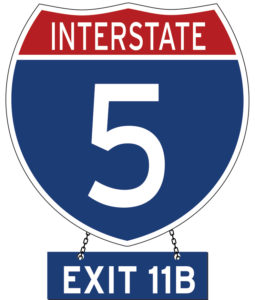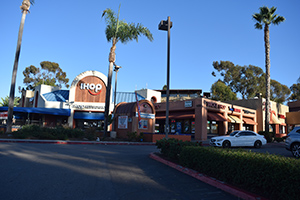Schlepping and Schmoozing Along the Interstate 5, Chapter 16, Exit 11 B (Plaza Boulevard): International House of Pancakes

 Follow Plaza Boulevard east to 1430 E. Plaza Boulevard, to the International House of Pancakes at the eastern end of Bay Plaza Shopping Center, on the right-hand side of the street.
Follow Plaza Boulevard east to 1430 E. Plaza Boulevard, to the International House of Pancakes at the eastern end of Bay Plaza Shopping Center, on the right-hand side of the street.
The International House of Pancakes at the Bay Plaza Shopping Center in National City was built in conformance with the shopping center’s architectural guidelines, rather than in IHOP’s usual configuration. However, it still has a trademark blue roof, and its menu is fairly typical of some 1,500 other establishments in the family restaurant chain created by two Jewish brothers. Al Lapin Jr. and Jerry Lapin started IHOP in 1958 in the tony San Fernando Valley neighborhood of Toluca Lake.
In case you haven’t heard of Toluca Lake, it is in the southeastern San Fernando Valley, wedged between Studio City on the west and Burbank on the east. It has a long litany of famous residents, stretching back to still-missing aviator Amelia Earhart and husband George P. Putnam, the book publisher, and later including various Hollywood celebrities who liked the community’s proximity to the movie and television studios in Burbank. Among these performers were Bob Hope, Frank Sinatra, William Holden, Bette Davis, Bing Crosby, Dorothy Lamour, W.C. Fields, Steve Carrell, Viola Davis, and Miley Cyrus.
The Lapin brothers initially operated Coffee Time, which serviced offices with urns of coffee. Inspired by the success of McDonald’s, which Ray Kroc was building into a world-famous brand, they decided to see if people could be lured to restaurants featuring pancakes and waffles. True to their business origins, they decided that each table would receive its own never-empty pot of coffee, which patrons could pour for themselves rather than waiting for a waitress to come by.

Initial recipes for the pancakes and waffles were tested in the kitchen of the mother of the Lapin brothers, Viola Lapin. Besides American-style pancakes, the Lapins had their staff research and develop pancakes and crepes styled after those popular in other countries. Chefs also came up with some pancakes of their own, including one called Tahitian Orange Pineapple. Trays on the tables offered a selection of syrups, including maple, boysenberry, strawberry, and blueberry.
The first restaurant was intentionally built in the shadow of a Bob’s Big Boy restaurant, the idea being that if people had to wait for a table at Bob’s, they might be willing to experiment on pancakes instead. Al’s wife, Marilyn, served as the first restaurant’s cashier, stowing their son, Randy, in a basinet under the register.
Pancakes in a family restaurant setting caught on and by 1962, the Lapin brothers were able to expand their chain to 50 restaurants, including one in Woodland Hills, California – on the western side of the San Fernando Valley – which was the first to feature the signature blue roof and A-frame construction. Many of the subsequent restaurants were franchised, with the roof design inspired by the national Howard Johnson restaurant chain, which had orange roofs.
Al Lapin Jr. created International Industries, a conglomerate that went on to own other restaurant/ food service chains (Orange Julius, Wil Wright’s Ice Creams, the Original House of Pies, Love’s Wood Pit Barbecue, Golden Cup Coffee Shops, and Copper Penny Coffee Shops) as well as such retail establishments as Michael’s Artist & Engineer Supplies, House of Nine, Shirt Gallery and a security company and secretarial schools. Al was the conglomerate’s chairman and president; Jerry served as executive vice president.
Perhaps it was over-expansion, perhaps the recession of 1970 and 1971, perhaps it was failing to react to complaints from franchisees that they were being overcharged for supplies, but by 1973 the company was in financial trouble, and Lapin traded his stake in it for a mere $50,000. International Industries changed its name in 1976 to IHOP, Inc, becoming a publicly traded company in 1979. In 2007, IHOP acquired the Applebee’s International Chain for more than $2 billion. The conglomerate’s name was then changed to DineEquity Inc., and in 2018 changed again to Dine Brands Global. The corporate headquarters is located in Glendale, California, adjacent to Burbank.
Jerry Lapin remained with the Dine conglomerate, whereas after selling his interest in International Industries, Al was down, but not out. He decided in 1974, to get back into the breakfast business by buying Uncle John’s Family Restaurant in Santa Monica, as well as Quickprint, a company based in Toledo, Ohio, that was in bankruptcy. He even tried a company that delivered pizzas and videos. Al ultimately declared bankruptcy in 1989.
During his tumultuous career, Lapin served in the presidencies of the International Franchise Association, the United Liver Association, the Young Presidents Association, and the Southern California Restaurants Association.
Al Lapin died of cancer in 2004 at the age of 76. He was entombed in a mausoleum at Eden Memorial Park, a Jewish cemetery in Mission Hills, located at the north end of the San Fernando Valley. Among Al’s eternal neighbors are comedians Marty Allen, Lenny Bruce, and Groucho Marx; actor Sam Jaffe; and Yedidia Shofet, once the chief rabbi of Iran and spiritual leader of Persian Jewry.
Jerry Lapin died in February 2022. Having earned a bronze medal as a lieutenant during the Korean War, he was buried at Arlington National Cemetery. During much of his life, he resided with his family in Sydney, Australia, where he owned a popular restaurant, served as a show business impresario, and also owned a shipyard. On his return to the United States, he headed a variety of companies including Topsy’s International, AdMarketing Inc., Sanwa Food Group, Detroit DISH TV, and Acme Coin Machine Company. He and his wife Gina had been married 64 years.
 *
*
Next Sunday, April 24, 2022: Exit 12 (Division Street): Paradise Village
This story is copyrighted (c) 2022 by Donald H. Harrison, editor emeritus of San Diego Jewish World. It is a serialization of his book Schlepping and Schmoozing Along Interstate 5, Volume 1, available on Amazon. Harrison may be contacted via donald.harrison@sdjewishworld.com
Nice article. I believe the year should be 1962 instead of 1952. They attempted to purchase Ramada Inns and there was talk they were making a bid for ABC television. The company was accounting for franchise sales as income, they should have been amortizing. They had a +- 50 million dollar write off in 1970, they were never able to overcome that. At one time they were bigger than McDonals. I put in most of my bar mitzvah money in the 1973. They sold off all their oprations except ihop, loves and Copper Penny by 1977. Frederick Jahh the German colonel s sanders and owner of Wienerwald bought the company in 1978 for 10 million dollars.He also owned Lums, another long gone chain. FYI, Lums was owned by the Perlman brothers who eventually sold it and bought Ceasers Palace. Their offices were on Lankershim Blvd. Jahn went bankrupt in 1980 and the banks took over. The company went public in the mid 80’s ipo of 50 million, the company is now valued in the billions. Al Lapin could never duplicate his success. Jerry died last month.
Mike: Thanks for the update. We’ve added Jerry’s death to the story. The date IHOP began was 1958, as reported in our story.
Interesting article, Donald, and I appreciate all the work you had to do to round up this information and put the story together for us.
But I believe Mike was referring to this passage:
“Pancakes in a family restaurant setting caught on and by 1952, the Lapin brothers were able to expand their chain to 50 restaurants, including one in Woodland Hills, California – on the western side of the San Fernando Valley – which was the first to feature the signature blue roof and A-frame construction.”
Ahhh now I see the typo in question. I have corrected it. Thank you Mike and Robert!
My pleasure to help. And thanks for ALL you’ve done for SDJW over the years, as well as for your current series.
See you at the next off-ramp …